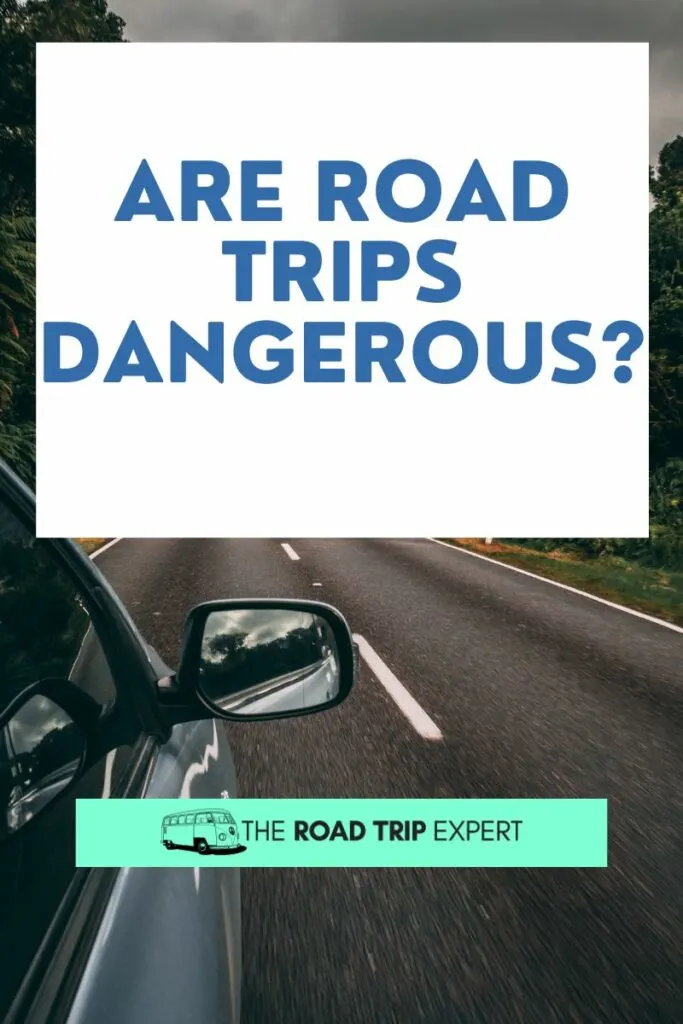Are you contemplating the open road, the freedom of a road trip, but find yourself hesitating due to safety concerns? You’re not alone. According to the National Highway Traffic Safety Administration, there were over 36,000 fatal motor vehicle crashes in the United States in 2019 alone. So, the question on your mind is valid:
Are road trips dangerous?
The short answer is yes, road trips carry inherent risks, but they are not inherently dangerous if you take the right precautions. For instance, the risk of getting lost can be mitigated by using reliable GPS and offline maps. Crime in unfamiliar areas can be alleviated through research and staying in well-reviewed accommodations. Health risks can be minimized by packing a well-stocked first-aid kit.
I’ve been on countless road trips, navigating treacherous mountain roads, dealing with car breakdowns, and everything in between. Yet, the rewards have far outweighed the risks. In this article, we’ll delve into what makes road trips potentially dangerous and how you can mitigate these risks to ensure a safe and enjoyable journey.
So, buckle up as we navigate the essentials of road trip safety, from assessing your vehicle’s condition to understanding the risks of different terrains and weather conditions.
What Makes Road Trips Potentially Dangerous?
Road trips offer the promise of adventure and freedom, but they also come with their own set of risks. Nothing in life is inherently risk-free. Understanding potential dangers is the first step in mitigating them and ensuring a safe journey. Here’s a rundown:
- Getting Lost: It’s easy to lose your way, especially in areas without cell service. During my road trips across America, my GPS has been a lifesaver. However, a GPS glitch once left us stranded on a small country road, so now I always check the map before we hit the road.
- Crime in Unfamiliar Areas: Different places have varying crime rates. Thorough research and local knowledge can help you avoid risky areas during your travels. You can also trust your gut in many situations. If it doesn’t feel right, move on.
- Potential Health Risks: Prolonged sitting and driving can lead to health issues like back pain. I’ve pushed myself for too long on several trips, and my lower back always regrets it.
- Home Security Concerns: An empty home can be a target for burglars. Smart home security systems can give you peace of mind during your trips.
- Driving Safely: Speeding and reckless driving increase the risk of accidents. Never underestimate the value of cautious and defensive driving.
- Drowsy Driving: Fatigue can impair your driving skills. Limiting driving to eight hours a day will help you stay alert on the road.
- Weather-Related Risks: Bad weather can make driving hazardous. Pull over if the weather gets too bad, and always be prepared with emergency supplies in case of sudden storms.
- Vehicle Breakdowns: Mechanical failures can happen unexpectedly. My well-stocked repair kit saved us multiple times when our Silverado had issues.
For more information, check out our blog: How To Stay Safe On A Road Trip.
Safety Measures to Take During the Trip
Embarking on a road trip is an exhilarating experience, but it’s crucial to prioritize safety to ensure a smooth journey. From taking regular breaks to being prepared for unpredictable weather, there are several measures you can take to mitigate risks.
- Regular Breaks: One essential safety measure is taking frequent breaks. According to the National Sleep Foundation, you should stop at least every two hours or 100 miles to rest and stretch. I’m the type that wants to get from point A to point B as quickly as possible, but adhering to this rule can significantly reduce fatigue and improve focus. For more on this, read our guide on How Frequently Should You Take Breaks When Driving Long Distances?
- Emergency Kit: Another crucial component is having a well-stocked emergency kit. Your kit should include a first-aid kit, water, non-perishable food, and essential tools. I learned the hard way when my car broke down in the Carolinas that having an emergency kit was a lifesaver. If you’re driving at night, check out: 10 Safety Tips To Prepare You For Driving At Night.
- GPS and Backup Map: Your GPS app is your best friend on a road trip, but don’t solely rely on it. Always have a physical map as a backup. There have been several instances where the GPS failed during my trips, especially in remote mountainous regions. Our article, How To Drive Safely In The Mountains, offers invaluable advice for those planning to drive through such terrains.
- Weather Preparedness: Weather conditions can be unpredictable, so it’s essential to be prepared for all scenarios. If you’re concerned about driving in wet conditions, our article 15 Tips on How to Drive in the Rain Safely is a must-read.
Is My Car Safe for a Long Road Trip?
Before you hit the road, ensuring your car is in top condition is crucial. Start with a comprehensive inspection at least two weeks before your trip. Check the tire pressure, including the spare, and your vehicle’s fluids—oil, coolant, and brake fluid—should be at optimal levels. A quick visit to a certified mechanic can confirm this and allow time for necessary changes.
Don’t forget to inspect the brakes; worn brake pads can reduce your stopping distance by up to 10 feet at 60 mph. Lastly, ensure your car battery is less than three years old or has passed a recent load test. A failing battery is one of the leading causes of breakdowns, especially in extreme temperatures.
For more on tire safety, check out our article: How Far Can You Drive on a Spare Tire?
How Far Is Too Far to Drive Every Day?
Determining how far to drive each day is crucial for both your safety and enjoyment on the road. The American Automobile Association (AAA) recommends limiting daily driving to approximately 500 miles or about 8 hours behind the wheel. However, this can vary based on factors like road conditions and driver fatigue. Don’t try to push beyond your limits; it’s never worth it.
During one of my cross-country road trips, I found that sticking to a 400-mile daily limit was more realistic, especially when navigating challenging terrains along the Pacific Coast Highway. This allowed ample time to take breaks, enjoy the scenery, and handle unexpected situations.
For more information, check out: 11 Helpful Road Safety Tips For Every Long Drive
How Far Should You Drive Without Stopping?
It’s not just about the distance, though; it’s also about how often you stop. How Frequently Should You Take Breaks When Driving Long Distances? recommends taking a 15-minute break every two hours or 100 miles to stretch, hydrate, and refocus. These breaks can reduce the risk of accidents significantly. You won’t believe the difference these stretch breaks can make at the end of the day.
What States to Avoid on Road Trips?
When planning a road trip, you should consider the safety of the states you’ll be traversing. Some states have higher crime rates than others. Road conditions also play a significant role and vary from state to state. Some states are notorious for their pothole-ridden roads, which can be hazardous. Another critical consideration is the local climate. Check weather forecasts and have contingency plans in place.
Proper planning can significantly mitigate all risks. This includes researching the safest routes, understanding local laws and crime rates, and preparing for various weather conditions. A well-thought-out plan can be your best defense against the uncertainties of the road.
For an extra layer of protection, consider investing in travel insurance that covers road trip-specific risks. How To Choose Travel Insurance offers a comprehensive guide to selecting the right policy for your journey.
- 4K+1080P DUAL RECORDING- REDTIGER brings to you…
- SUPERIOR NIGHT VISION- The driving recorder adopts…
- WiFi/SMART APP CONTROL- You just need to connect…
What To Do If Something Goes Wrong On The Road Trip
Emergencies can happen, even with the best-laid plans. If your car breaks down, your first step should be to pull over to a safe location, at least 5-10 feet from the road. Turn on your hazard lights and set up reflective triangles 30 feet behind your vehicle to alert other drivers. Call for roadside assistance and wait inside your car with the doors locked.
Legal issues can also arise, such as traffic violations or accidents. In such cases, remain calm and contact local authorities. Provide all necessary documentation, like your driver’s license, registration, and insurance. It’s advisable to have a digital copy stored on your phone as a backup.
Having a dash cam can be a lifesaver in these situations. It provides evidence in case of an accident and can also monitor your car when you’re not around. Here are 10 Reasons Why You Should Get A Dash Cam to understand its importance better.
Wrapping It Up: Are Road Trips Dangerous?
So, while road trips come with risks, they are not inherently dangerous endeavors if approached with caution and preparation. A well-planned trip can mitigate most risks, turning what could be a hazardous journey into an adventure of a lifetime. Drawing from my extensive experience, including a challenging yet rewarding road trip across Europe, I can attest that the rewards of road-tripping far outweigh the risks.
So, don’t let fear hold you back. Equip yourself with the proper knowledge, tools, and a dash of adventurous spirit.



